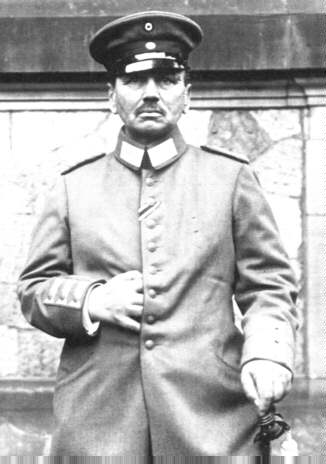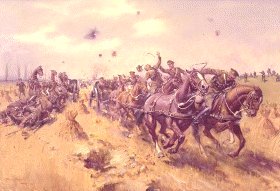 | ||
| The Retreat - Le Cateau and The Marne |
| World War One - The War To End All Wars |
The Battle that Defined an Army

25 August 1914: The BEF had been in retreat since the 22nd and needed rest badly. The men were tired, bloodied and battered, but they were not beaten. They took a sense of pride with them from Mons. Though they were forced to pull back they knew the Imperial German Army had been given a wake up call; the BEF was on the continent.

General Alexander von Kluck, and the Imperial German 1st Army were following the Schliffen plan to the letter. The right flank was moving westward and ready to "brush its sleeve in the channel." The morale was high in the ranks and the soldiers thought victory would come any day. General von Kluck was beginning to put a picture together of the British retreat, but due to misleading air reports he received on the evening of the 24th he was mistaken as to where the British were heading. These reports lead him to believe that the British Army was retreating on the fortress town of Maubeuge. General von Kluck now saw the opportunity to finish the pesky British. This would provide an excellent opportunity for his forces to envelop and then crush the BEF. Afterwards he could turn his forces against the left flank of the French Army and finish them off.
Early a.m. 25 August: Von Kluck received a new air report showing the British moving in almost the opposite direction. At once new orders were given. The German III Korps pushed southeastward through the Forest of Mormal as the advanced guard pushed south. Skirmishes occurred at the towns of Maroilles and Landrices. At Landrices, as General Sir Douglas Haig's men of I Corps were entering the town they came upon a body of troops wearing French uniforms. When questioned, the officer in charge answered in French. Haig's men found nothing strange and continued down the road. Without warning, the French soldiers lowered their bayonets and charged. These were not French but men of von Kluck's IVth Korps. This dastardly trick caught the British off guard and a fight ensued that comprised about 2 regiments and a gun battery. Under the cloak of darkness Haig thought he was under attack from a much larger force. He telephoned HQ: "heavy attack ...send help... situation very critical." Haig was normally a cool headed thinker, this report worried Sir John and he believed I Corps to be in grave danger. He now feared envelopment; he sent the order for Haig and his men to retreat. Haig's exaggerated report caused Sir John to panic, and he believed now more than ever the retreat must continue.
The Belgian Army was looking for a way to help the beleaguered British and French forces fighting on the River Sambre. They came up with a plan on 25 August, to make a sortie out of Antwerp and strike the German communications line. The resourceful Belgians were at first successful but by the 26th they were forced to retire to the safety of Antwerp.
25 August, 19:30 hours: From his headquarters at St. Quentin, Sir John French gave the order to continue the retreat. Sir John's mood had grown very bitter. He had begun to blame the situation on the French under General Lanrezac and, as Sir John called it, his "headlong retreat." Sir John reported to Kitchner that his men were not at all eager to run. He said, "I shall explain to them that the operations of our Allies are the cause of this."
Late evening 25 August: Smith-Dorrien arrived in Le Cateau some hours ahead of his forces. He searched for Sir John French but to his dismay he found French had already left. Instead he found French's Chief of Staff Sir Archibald Murray. Smith-Dorrien needed a report on General Haig's Corps. Were they still to bivouac that night 12 miles away at Landrecies, or continue their march? Murray could tell him nothing. Murry had not been informed of Sir Johns order for I Corps to continue the retreat.
General Smith-Dorrien, had been given command of II Corps only five days earlier. He found himself in charge of an army of exhausted men. He was now separated from General Allenby's cavalry and could not count on any useful cover for his retreat. After a conference with his divisional commanders it was decided that any further retreat would be futile. Against Sir John's orders the decision was made to stand and fight.
Early morning August 26: The men of II corps were arriving in Le Cateau. They were tired, worn, and in generally low spirits. Here the word was given , they would stand and fight. They hurried to set up a skirmish line but found little cover. They were forced to deploy in the open ground, on a forward slope along the Le Cateau-Cambrai road west of town. Vulnerable and exposed the men started to dig in.
To the north lay the high ground and the Germans. From here their heavy guns could pummel the British in the open ground. The men and artillery of the BEF were badly exposed. Several of the British batteries were right on the firing line with the infantry. Other batteries were only a short distance to the rear. Enemy pressure had made it impossible to dig anything other than the most rudimentary defenses. The inadequacy of these excavations would soon be apparent. Small valleys and dead ground permitted the enemy to approach without being observed. To the left of the lines civilians had dug a few trenches that were readily used by the BEF.
The men of the 5th corps held the right wing of the defense. It was their job to cover the crossroads west of the town where they were located on both sides of the Roman road leading to Reumont. To their left was the 3rd Division, and further to the left was the newly arrived 4th Division. The 4th division had placed itself under Smith-Dorien's command for the battle. In reserve was the Cavalry Division of the 19th Infantry Brigade. Other infantry units in the area consisted of two companies of the East Surreys, Duke of Cornwall's Light Infantry, 1st Queens Own Royal West Kents, 2nd King's Own Scottish Borderers, and on the road to Reumont facing to the north were the King's Own Yorkshire light infantry. Artillery consisted of the guns of 122, 123 and 124 Batteries. To the right were the guns of 52 battery, 37th battery with its howitzers, 80th battery, and 11th battery. They were positioned in the open on the high ground at Rambourlieux Farm, 2 miles northwest of Le Cateau.
August 26 6:00 a.m.: Gray and cloudy, a mist hung in the overcast sky as the German guns opened fire from northeast of Le Cateau. This continued off and on until around 8:00 am. Soon small-arms fire was directed at the British from west of Le Cateau. Under the cover of mist and fog the Germans tried to advance against the British right flank; they had walked into a hornet's nest. The volume of accurate British fire was devastating. Field artillery joined in and soon the Germans were forced to fall back.
August 26 10:00 a.m.: The German guns unleashed a maelstrom of steel inflecting heavy losses to the besieged British forces. The men of The King's Own Yorkshire Light Infantry, and the Suffolks who held the front line were literally pulverized by high explosives and shrapnel. Now the Imperial German Army began their attack. Like a great gray sea the Germans advanced on a 2-mile front from the valley of the Selle to Rambourlieux Farm. These huge formations proved deadly for the Germans. What followed can only be described as a massacre. The rifles and field guns of the BEF took the lives of many brave Germans. The toll was also great on the British. The unceasing artillery, machine gun, and rifle fire flailed the men of the BEF. Only one gun of 11 Battery was now operational. The guns of the remaining batteries rained death on the advancing Germans. The guns 122 batteries wiped out a whole platoon of Germans. The others broke for cover.
26 August Noon: Machine gun fire and rifle fire was battering the Suffolks, and the final gun of 11 battery was now out of action. Hastily the men of the 2nd Manchesters, the Argylls, and Sutherland Highlanders were ordered up to help the beleaguered Suffolks but they were strafed by enemy fire and suffered severe losses. Steadily the German attack continued. Towards the left flank the Germans mounted an attack but were repelled by the rifle fire of the BEF. Again the valiant Germans rallied and charged. Under a hail of bullets, some determined forces made it across the Cambrai Road but were chopped down by the machine gun of the Royal Scots near Audencourt. To the far left the British were under heavy attack from artillery and machine gun fire. The King's Own Royal Lancasters had 400 casualties. The Lancashire Fusiliers were being hit hard by some of the 21 machine guns the Germans had in that sector.
1:00 p.m.: The situation was now critical. The guns of 122, 123, and 124 batteries were in jeopardy. A call went out for volunteers to retrieve the guns. Captain R.A. Jones of 122 battery gathered his men and six fearless teams of horses and was ready to attempt the task. Jones inspired his men by leading them down the battered hillside towards the guns. German machine gun fire tore through the teams. Eight men, including Captain Jones, and twenty brave steeds fell. The other teams reached the guns and limbered up three of them. One team was shot down in the road. The other two galloped up the hill past the men of the West Kents. They waved their hats and cheered wildly as they galloped by. "It was a very fine site", stated one British officer.

Acts of courage filled the battlefield but none were more daring than the story of Captain Reynolds of the 37th Battery. With a hand full of volunteers they charged forward to rescue two howitzers that had been left in the open. With the Germans only 200 yards away the men limbered up the guns. They galloped away but one team fell to artillery fire. The other team of Reynolds and drivers Luke and Drain made it back. For their bravery in the face of death they received the Victoria Cross.
2:00 p.m.: It was now evident that the British could not hold out much longer. Plans were being made for a general retreat. The guns of 123 and 124 batteries could not be saved. The sights were smashed and the breeblock removed making them, worthless to the advancing Germans. All across the lines, the BEF was being over run. The men of Suffolks and Elements of the 2nd Manchesters, the Argyll, and Sutherland Highlanders were under heavy attack and were suffering severe losses.
2.30 p.m.: The end was near. The Germans had the Suffolks' on the ropes. They countered, fighting back fiercely. In company with the Argylls, they fought like Celtic warriors from the days of old. Scotsmen made a final stand next to Englishmen. All ancient feuds were put aside. Two of the Highland officers started counting aloud each one of their kills; alas, it was no use. They had taken artillery fire throughout the battle. Now the determined Germans rushed their position and, after fierce fighting, the Suffolks and Argylls were finally silenced. The Germans now turned their attention to the men of the King's Owen Yorkshire light Infantry. All across the battlefield the order was being given to fall back but they had not received this message. From the right rear and from the Cambrai road, the Germans attacked with rapid rifle and machine gun fire. The Yorkshire men took a pounding but held on. Finally, the Germans rushed their position and they were overwhelmed. Their last stand made it possible for the 5th division to start its retreat. Some members of the 3rd Division's West Kents and the Scottish Borderers were captured because they never received the order to fall back.
4:40 pm: French cavalry had finally arrived. They set up a line to the left rear of the British forces. Their rapid-fire artillery began to pound the Germans' flank. This diversion allowed 4th Division to slip away. To the north and east, many British divisions had not received the order to retire, and fought on. The BEF was now in full retreat. General Smith-Dorrien had already moved his HQ to St. Quentin.
Late afternoon 26 August: Darkness was falling on the battlefield, and with it came a drizzling rain. Isolated pockets of the BEF held out, forming a rear guard. These selfless deeds allowed the remaining forces to escape. Except for long-range artillery that did little damage, the BEF retreat was uncontested.
Tactical victory belonged the Germans; moral victory to the BEF. II Corps had not been overwhelmed, nor had they been destroyed. Loses were high for the British - 7,812 men had perished and thousands more were captured. German forces had suffered even heavier losses. The uncontested retreat of the BEF gave the Allies breathing space and time to regroup. Smith-Dorrien had disobeyed Sir Johns' order to retreat and Sir John never forgave him. Yet his brave decision, although costly, had saved the war for the Allies. On the German side, it became evident they could not afford another victory like the one at Le Cateau.
|
|
|||||||||
|
|
|||||||||
| |||||||||